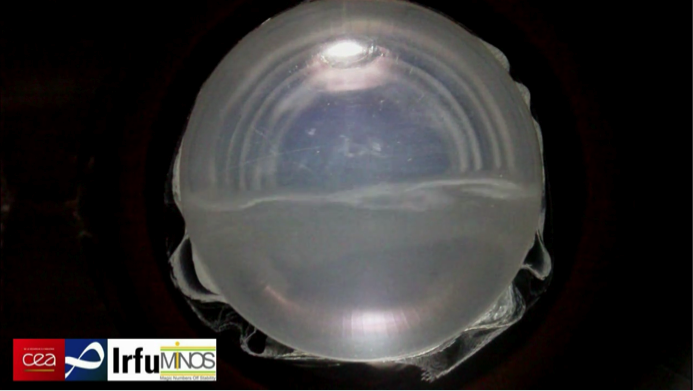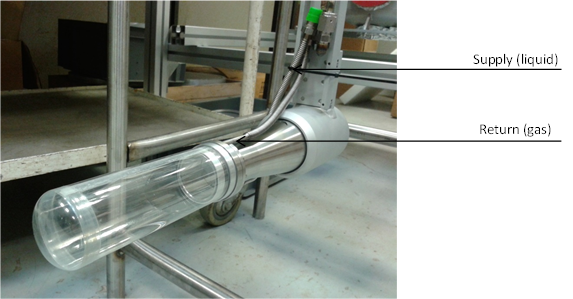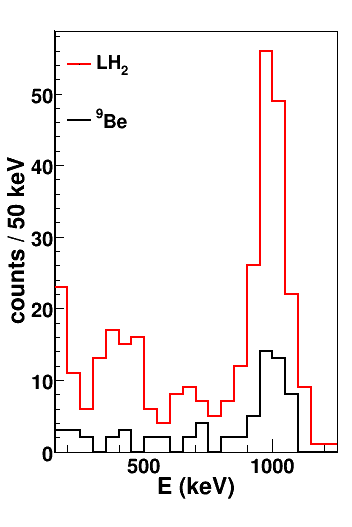Technical Description
The Liquid Hydrogen target
RIKEN and CEA teams have experience developing cryogenic hydrogen targets. In particular, the cryogenics team at CEA IRFU/SACM developed targets for GSI experiments, the last in date being the PRESPEC target [louchart], and is currently recently responsible for the development of the CHyMENE target [gillibert], a very thin windowless pure hydrogen for low-energy studies.
The MINOS target cell is made of Mylar. The diameter of the entrance (exit) window are 40 (56) mm. The target length may be changed from one experiment to another. Available lengths today are 100 mm, 150 mm and 200 mm. The target is divided into two parts. The first part consists of a stainless steel body with filling and return gas tubes and the Mylar entrance window (125 micron thick). The second part is the Mylar cell (150 micron thickness).
Hydrogen is cooled and liquefied in contact with the second stage of a closed-cycle refrigeration system by SHI SUMITOMO. This configuration limits liquid volume to about 100 cm3. The target is connected to a storage tank through two separate check valves. The final pressure in the storage tank will be 1.05 bars. This eliminates all risks of explosion fueled by oxygen leaking into the system. This pressure will be the vapor pressure of the liquid, corresponding to a temperature of 20.5 K for hydrogen.
The target cell is located inside a sealed vacuum chamber which provides a secondary containment volume in case of target rupture. The hydrogen to be used in the target will be stored in a tank of about 1000 liters. The gas pressure in the tank will be approximately 1.35 bars when all the gas is in the tank, and slightly over 1 bar when the target cell is filled.
More details can be found in [obertelli].
The vertex-tracker
The tracking is essential to determine the vertex position and therefore to allow the use of a very thick target. The trajectories of protons will be analyzed using a cylindrical Time Projection Chamber (TPC). The TPC will surround the target and be 300 mm long to access the detection of particles emitted at small angles (see a schematic view below). In the case of (p,pn) reactions, it corresponds to the detection of the unique recoil proton and the projectile-like residue whereas in the case of $(p,2p)$ reactions the projectile-like residue can be detected in coincidence with up to two protons.
Drift electrons will be amplified on the backplane of the TPC through a Micromegas amplification stage. Charges will be induced on a pixelized readout plane with pads of the order of 2-4 mm2. Signals will be digitized via a specific electronics and readout. The Front End Cards (FEC) can be equipped by AFTER chips or AGET chips, both developed at CEA Saclay.
Electronics and Data Acquisition System
The MINOS detectors is conveyed with it own electronics. The 5000 channels of the TPC and ancillary detectors (external position-sensitive Micromega layer and DSSSDs) are readout by a digital electronics developed at CEA Saclay composed of FEC cards equipped with AGET chips and connected to the so-called FEMINOS readout card. The full system is composed of 20 cards. All cards are synchronized through the Trigger Clock Module (TCM) that also delivers the common trigger to all cards.
The maximum trigger rate of the electronics is limited to several kHz.
The MINOS system has its own acquisition system which can be coupled to the RIBF DAQ.
Resolutions
To properly define the experimental conditions of your experiment, realistic simulations can be performed with the MINOS simulation package (to be available soon). Case by case simulations can be performed on request (contact Anna Corsi at acorsi@cea.fr).
For a first order estimate of the MINOS response, the following items have to be considered:
- Beam absorption and re-interaction probability in the target lead to a reduction of the statistics compared to a pure linear scaling with the cross section and target thickness. A simulation using INCL4.10 for 53K(p,2p) at 250 MeV/nucleon as a function of target thickness is shown on the figure below. A 30% reduction for a 150-mm target for medium-mass nuclei is a typical value.
- MINOS has been defined to achieve a vertex resolution of 3 mm FWHM for (p,2p) reactions involving medium-mass nuclei at energies above 200 MeV/nucleon. To give an example, realistic simulations for 53K(p,2p)52Ar at 250 MeV/nucleon gives a resolution of 2.8 mm FWHM. In the case of Ca(p,pn) reactions at similar energies, a vertex resolution of 4 to 5 mm is found.
- Depending on the reaction, the efficiency of detecting at least one proton (and therefore being able to determine the vertex position) differs. In typical cases of (p,2p), the efficiency is simulated to be 85%. For (p,pn) reactions, the efficiency drops to 65%. In the case of (p,3p) reaction, the efficiency rises above 95%.
- Typical gain of MINOS in terms of gamma statistics is shown in the following simulation for the 53K(p,2p) at 250 MeV/nucleon, assuming a 1 MeV transition and the use of DALI2. Note that the gain is limited here by the intrinsic resolution and size of the DALI2 detectors.
[louchart] C. Louchart et al., Nucl. Instr. Meth. A 736, 81 (2014).
[gillibert] A. Gillibert et al., Eur. Phys. J. A 49, 155 (2013).
[obertelli] A. Obertelli et al., Eur. Phys. J. A 50, 8 (2014).







